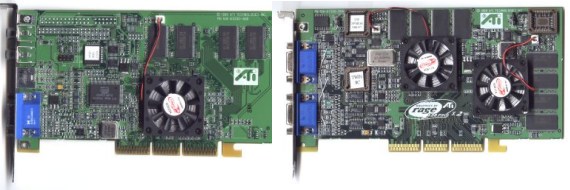ATI Rage Fury Pro Review
Introduction
The majority of the performance-hungry 3D-gamers may not even be aware of it, but ATi has been the most successful 3D-chip and 3D-card maker for quite a while now in terms of sold units as well as revenues. Many of you may ask why. The secret behind ATI's success is very different to the 'make the fastest 3D-chip so you'll be most successful'-approach of 3Dfx or NVIDIA. ATI has been able to supply the market with decently performing 3D-hardware at very reasonable prices, with an excellent list of additional features, a good support and the ability to deliver product very reliably. This is why OEMs love ATI and you won't find any OEM or large system integrator that does not use ATI-cards in at least some of its product lines. Whilst 3Dfx and NVIDIA were fighting for the 3D-crown, ATI sat back and simply sold their products in a very professional manner. Those products weren't necessarily the fastest, but the performance was good enough, the list of multimedia-features was just what OEMs required, the pricing was decent and the products were delivered reliably.
Now this does of course not mean that ATI wouldn't have to be able and supply well performing products too. ATi's Rage 128 was not quite able to compete with the fastest 3D-chips anymore by the time when 3Dfx released their Voodoo3 and later on when NVIDIA brought RIVA TNT2 to the market. Still Rage128-products sold fine, but eventually the people expected more performance from ATI as well. Now ATi's next chip Rage 128 Pro is ready to close the gap, and starting to compete against the top 3D-performers of the last 8 months. ATI-cards with this new chip are again not targeted to reach for the 3D-crown, but you'll see that those cards will again sell very successfully, again for the same reasons mentioned above.
We had a close look at the Rage Fury Pro and a prototype of the Rage Fury MAXX, to see what kind of performance we can expect from the new ATI-chip and how it stands up against its competitors.
The Specifications Of Rage 128 Pro
The name already shows it, Rage 128 Pro is not a completely new chip, but an enhanced Rage 128. The most obvious enhancement is of course the core and memory clock. Rage 128 Pro is clocked at 125 MHz and the memory runs at 143 MHz. This increases the fill rate to 250 Mpixels/s and improves memory bandwidth for high resolutions or 32-bit color depth. You will certainly realize that 250 Mpixels/s are just as much as a normal NVIDIA RIVA TNT2 chip is able to supply and even less than the fill rate of a 3Dfx Voodoo3 2000. Thus there's no reason to expect miracles from the new Rage 128 Pro products and if you compare it to the predecessor Rage 128 you have hardly any reason to expect more than a 25% increase in frame rates. If you run Powerstrip to test the clock speeds, you'll get the incorrect value of 143/155 MHz, just in case you've read different clock speeds somewhere else.
Here is a list of other important changes:
| Change | Advantage |
|---|---|
| Enhanced triangle setup engine that increases the performance from 4M triangles/sec to 8M triangles/sec | In complex, high polygon count scenes you can see a significant improvement over Rage 128 |
| Improved texture filtering over Rage 128 | Increased image quality |
| DX6 texture compression support | With texture compression support developers can use very detailed textures without losing performance |
| AGP 2/4X | The Fury Pro will support the 4X AGP standard |
| Flat panel support through TMDS transmitter | DVI versions of the card will be available (note our test version did NOT come with DVI) |
| ATI Rage Theatre chip which allows video encoding/decoding | Thanks to this chip, you will have increased DVD play back performance |
DVD Playback
ATI has had an excellent track record when it comes to DVD playback but they've taken another step forward worth mentioning. While running some preliminary tests with a beta DVD benchmark THG is working on, I've seen no competition for ATI in regards to DVD playback quality / performance. Let's look at how ATI decodes an MPEG-2 stream. I'll list the process below and then show you the historical advances in hardware that ATI has made since Rage II+.
- Parsing
- Variable Length Decoding (VLD)
- Inverse Quantization (IQ)
- Inverse Scanning (IS)
- Inverse Discrete Cosine Transform (IDCT)
- Motion Compensation
| Feature | Rage II+ | Rage Pro / LT Pro | Rage 128 / 128 Pro |
|---|---|---|---|
| YUV to RGB Conversion | Supported | Supported | Supported |
| Filtered X/Y Scaling (720x480) | Supported | Supported | Supported |
| Motion Compensation | Row 2 - Cell 1 | Supported | Supported |
| YUV 4:2:0 Planar | Row 3 - Cell 1 | Supported | Supported |
| AGP 2X Bus Master | Row 4 - Cell 1 | Supported | Supported |
| iDCT | Row 5 - Cell 1 | Row 5 - Cell 2 | Supported |
The strong hardware assist in the Rage Fury Pro along with its higher clock speeds gives it outstanding DVD playback that is unparalleled by any other card aside from a dedicated hardware MPEG-2 decoder. Even then the differences are arguable. The main reason for the high MPEG2-decoding performance of the Rage 128 family is the integrated iDCT, which cannot be found in any other 3D-chip. It is also very useful as DCT used for MPEG2-encoding of your own videos, something that can be performed beautifully by the Rage 128 Pro.
Get Tom's Hardware's best news and in-depth reviews, straight to your inbox.
Current page: Introduction
Next Page Rage Fury MAXX Or Aurora, "The Golden Girl"